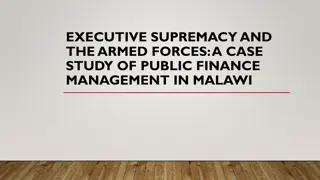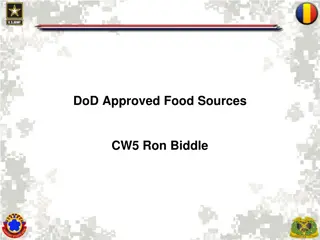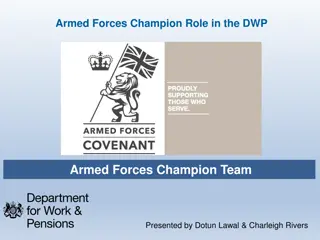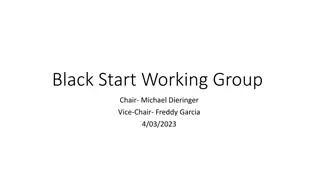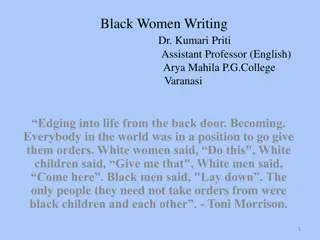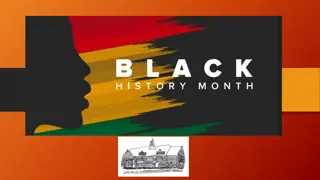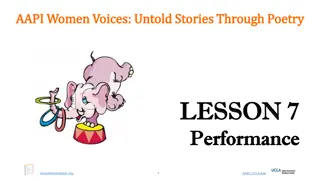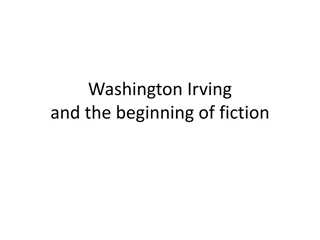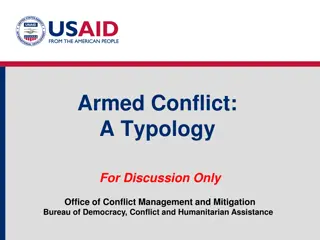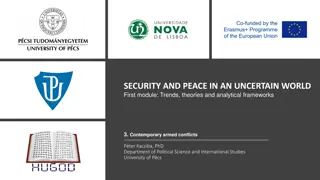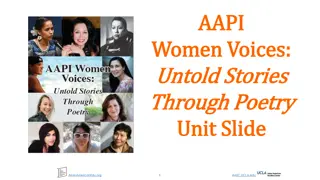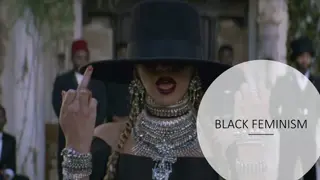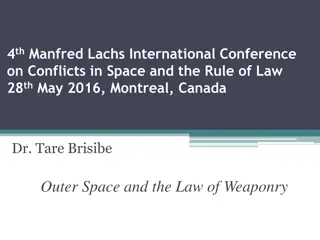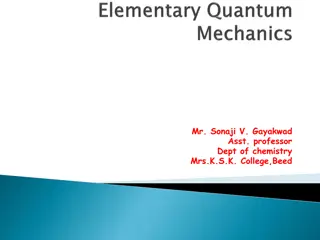Unveiling Untold Stories of Black American Involvement in Armed Conflicts
Discover the overlooked narratives of African Americans in historic armed conflicts, from the War of 1812 to Civil War battlefields. Explore individual accounts such as Ann Stokes, challenging conventional perceptions and benefiting from preservation programs like the American Battlefield Protection Program and Telling All Americans Stories initiative.
Download Presentation

Please find below an Image/Link to download the presentation.
The content on the website is provided AS IS for your information and personal use only. It may not be sold, licensed, or shared on other websites without obtaining consent from the author.If you encounter any issues during the download, it is possible that the publisher has removed the file from their server.
You are allowed to download the files provided on this website for personal or commercial use, subject to the condition that they are used lawfully. All files are the property of their respective owners.
The content on the website is provided AS IS for your information and personal use only. It may not be sold, licensed, or shared on other websites without obtaining consent from the author.
E N D
Presentation Transcript
A New Tide: Armed Conflict through the Eyes of Black America
What are their stories? During the War of 1812, the promise of freedom led many African American slaves to side with the British. Some 600 former slaves chose to serve as Colonial Marines and took part in the British attacks on Baltimore and Washington D.C But they didn t have to thousands of other freed blacks would be evacuated to British colonies in Canada and the Caribbean. So why did hundreds of freed men choose to fight? What are their stories? How do those stories change our understanding of the history of the United States?
Who were they as Individuals? Ann Stokes was first taken aboard a Union Naval vessel as "contraband" in 1863. She was hired as a nurse and worked under the direction of the Sisters of the Holy Cross. Ann became the first African American woman to serve on board a U.S. military vessel, the USS Red Rover. The USS Red Rover was the United States first hospital ship and would treat nearly 3000 patients onboard.
What is the American Battlefield Protection Program? The National Park Service s American Battlefield Protection Program (NPS ABPP) assists citizens, public and private institutions, and governments in planning, interpreting, and protecting sites where historic battles were fought on American soil during the armed conflicts that shaped the growth and development of the United States. Legislative Authority: 54 U.S.C. 308102
Telling All Americans Stories Preservation Planning Grant (2019): The US Colored Troops and North Carolina s Civil War Battlefields Recipient: North Carolina Department of Natural & Cultural Resources Project Highlights: This project is focused on researching the movement and impacts of the USCT at 20 Civil War battlefields in North Carolina and using that research in future preservation planning and interpretation across the state.
Battlefield Preservation Grant Programs Battlefield Restoration* Preservation Planning Land Acquisition Interpretive Modernization* Annual, competitive Rolling Annual, competitive TBD No match 50% match 50% match 50% match All periods of history Rev War, 1812, Civil War Rev War, 1812, Civil War Rev War, 1812, Civil War Planning, research, and outreach activities excluding bricks-and-mortar preservation or restoration work Land acquisition by state and local governments Reimagining battlefield interpretation using technology planning and implementation level Restoration of landscapes to day-of-battle conditions, including plans and studies $1.9 million per year $10-13 million/year Up to $1 million/year Up to $1 million/year *Authorized but not yet an active funding opportunity
Preservation Planning Grant Basics Battlefield Preservation Planning Grants fund documentation, research, planning, partnership building, interpretation, and outreach Projects can focus on battlefields and associated sites from any period in American history Grants are awarded annually through a competitive merit review process Typical awards range from $30,000-$100,000, and no match is required Grant projects are typically completed in two years
Stories Big and Small Prior to 1916, over 90% of the black population of the United States lived in the South. But over the following 60 years almost 50% would move north and west into more industrialized, urban environments like the cities of Detroit and San Francisco. The second wave of this Great Migration took place during World War 2.
Stories Bound Together: Hunters Point Hunters Point in San Francisco, California was one of many shipyards that serviced the American Navy during World War 2 7% of the workforce was African American by 1945, and a large portion of that number were black women. Black women were often tasked with the most physically demanding and labor-intensive jobs. Black women made up a larger portion of the labor force than their white female counterparts.
Definitions 1. Eligible activities must focus on planning, interpreting, and preserving sites associated with armed conflicts that shaped the growth and development of the United States. Armed conflicts = periods of collective violence, characterized by specific events and bounded in time 2. Projects must contribute to the preservation of battlefields or associated sites that are thematically tied with events that occurred during an armed conflict. Themes for associated sites: Military Government, Law, Politics, and Diplomacy Intellectual History Economics of War Society Transportation
Eligible Activities Consultation and Partnerships Collections Stewardship Education Historical Documentation Exhibitions, Media, and Signage Planning Public Programs and Outreach Survey and Inventory
What is Not Eligible? Lobbying and Fundraising Land Acquisition Capital Projects or bricks and mortar preservation work Battle Reenactments Activities that could harm a battlefield s integrity (e.g. large scale archeological data recovery, metal detection without a research design) Research unrelated to place-based preservation and stewardship Projects unrelated to battlefields and associated sites
Eligible Applicants State and local governments Public and private institutes of higher education Nonprofits having a 501(c)(3) status Federally recognized Native American tribal governments, other Native American tribal organizations, and Native Hawaiian Organizations
North Carolina Revisited Preservation Planning Grant (2019): The US Colored Troops and North Carolina s Civil War Battlefields Recipient: North Carolina Department of Natural & Cultural Resources Project Highlights: This project is focused on researching the movement and impacts of the USCT at 20 Civil War battlefields in North Carolina and using that research in future preservation planning and interpretation across the state.
How to Apply Search on Grants.gov: CFDA #15.926, or program name Download application package from Grants.gov: Notice of Funding Opportunity (NOFO) Standard application forms Complete and submit through Grants.gov Workspace
Application Components Grants.gov standard forms: SF-424 - Application for Financial Assistance SF-424A - Budget Information Non-Construction Programs SF-424B - Assurances Non-Construction Programs SF-LLL Disclosure of Lobbying Activities??? Project Narrative Budget Narrative Map Indirect Cost Rate Agreement, if applicable Other supporting documents
Merit Review: NOFO Section E Criteria Value 1. Preservation Opportunity 20 points 2. FY2021 Focus Areas 10 points 3. Objectives & Activities 20 points 4. Administration & Implementation 20 points 5. Partnerships & Engagement 20 points 6. Secretary of the Interior Priorities 10 points Highest Possible Total Score 100 points
Review & Award Timeline* February 12, 2021: February 2021: March/April 2021: April/May 2021: Risk assessment May 2021: Application deadline Internal review for eligibility and completeness Initiation of Section 106 review Competitive merit review Budget & scope negotiation (if needed) Grants awarded *This timeline may be subject to change
What Stories Do you Want to Tell? Do those stories include the experience of Black and African Americans? What can these stories tell us about the development of the United States?
Q&A What questions do you have?
Feedback Opportunity We want to hear from you! Do you have advice on how to make this funding opportunity relevant and feasible for Black and African American organizations and communities? What potential barriers do you see in applying for this funding? We welcome any other feedback, advice, and suggestions from today s audience.
Still have Questions? Contact us any time! abpp@nps.gov Philip Bailey: (202) 513-7126 Dr. Emily Button Kambic: (202) 354-2035 https://www.nps.gov/abpp Thank You . ..
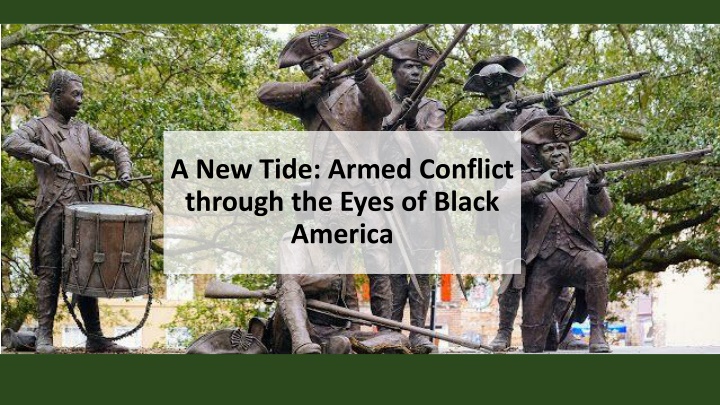

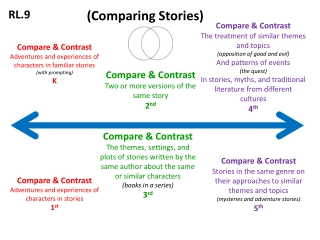
![Read⚡ebook✔[PDF] The Untold Stories of the Space Shuttle Program: Unfulfilled D](/thumb/21685/read-ebook-pdf-the-untold-stories-of-the-space-shuttle-program-unfulfilled-d.jpg)


